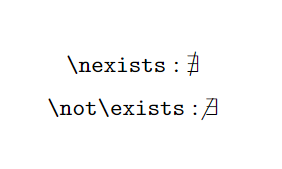Exist (∃), not exist (∄), and Only one exists (∃!) symbol in LaTeX
In this tutorial, you will learn how to print Exist (∃), not exist (∄), and Only one exists (∃!) symbols in a LaTeX document.
Print Exist (∃) symbol in LaTeX
In order to print the Exist symbol in LaTeX you have to use the \exists command. Also, you can use the semantic package with the same command, but there is no difference in the output.
\documentclass{article}
\begin{document}
$$ \exists $$
$$ \exists x \in ]x_1, y_1[ $$
\end{document}Output:

Print Not Exist (∄) symbol in LaTeX
To print the Not Exist symbol in LaTeX you can use the \nexists command provided by the amssymb package. Also, you can use the \not\exists command without any package but the \nexists command will give you a better output.
\documentclass{article}
\usepackage{amssymb}
\begin{document}
$$ \verb|\nexists| : \nexists $$
$$ \verb|\not\exists| : \not\exists $$
\end{document}Output:

Only one exists (∃!) symbol in LaTeX
This symbol is also known as the Uniqueness quantifier. To print this symbol in LaTeX you can use the \exists command and ! symbol from the keyboard. Like this \exists !.
\documentclass{article}
\usepackage{amssymb}
\begin{document}
$$ \verb|\exists| : \exists $$
$$ \verb|\nexists| : \nexists $$
$$ \verb|\exists !| : \exists ! $$
\end{document}Output:

Leave a Reply